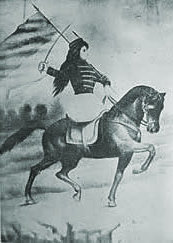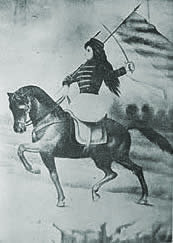
|
Women and Independence in Latin America An exploration of women's involvement in the Latin American Wars of Independence |

|

|
Women and Independence in Latin America An exploration of women's involvement in the Latin American Wars of Independence |

|
Click on the image below to see the full-size image
 Mercedes Abrego |
Gender:Female
Ethnic origen: Unknown
Events:
| 1770-1775? | - | Cúcuta | - | Not applicable | - | She was born between 1770 and 1775. |
| 1770-1775? | - | Socorro | - | Patriot | - | Her family was from here. |
| 1813-1814? | - | Cúcuta | - | Unknown | - | She was executed in 1813 or 1814. |
Connections:
Women donated clothes for patriotsBiography:
She was born in San Cayetano or Cúcuta, Colombia, in 1770 or 1775, and was executed without a trial by royalists in 1813 for her actions in the independence wars. The execution took place in front of her two sons who were then imprisoned for crying when she died. (Knaster, 481, 483,485.)
She was accused of making a brigadier's uniform for Bolívar. (Calle, 76-77)
Arciniegas describes her as having paid with her life (in Cúcuta) for the republican cause. (Arciniegas, 86)
Monsalve claims her family was from Socorro. She married Marcelo Reyes who owned the Urimaco hacienda where they cultivated cacao that was sent to Maracaibo. She was widowed before independence and had three sons, José Miguel, Pedro María and José María, all of whom were educated at the Colegio de San Bartolomé, Bogotá. Her family affirm that she paid with her life for presenting Bolívar with a frock coat. She went without protest, gave her blessing to her distraught sons, who had been sent by Santander to find out the movements of Matute and de Cañas. Her sons were then imprisoned for crying when she was executed. (Monsalve, 117-119)
In 1814 she was living in Cúcuta, a fervent patriot who took great pride that one of her sons was fighting in the republican army. She supported the guerrillas sending information to them and giving financial support. A seamstress, she made an elaborately embroidered uniform for Bolívar. When the royalists re-took Cúcuta she was brought before General Lizón, accused of making uniforms for Bolívar's troops and of having sons in the republican army. She was sentenced to execution on Morillo's orders. Her reaction was: "No me importa la vido sino la Patria. ¡Viva la Patria!" After her death, her body was exhibited and the Spanish officials cut off her head and displayed it for several days. (P. Forero, 18-20)
References:
Arciniegas, Germán (1961) América mágica: II Las mujeres y las horas
Calle, Manuel J. (1955) Leyendas del tiempo heroico
Forero, Paulo E. (1972) Las heroinas olvidadas de la independencia
Knaster, Meri (1977) Women in Spanish America: An Annotated Bibliography from Pre-Conquest to Contemporary Times
Monsalve, José D (1926) Mujeres de la independencia